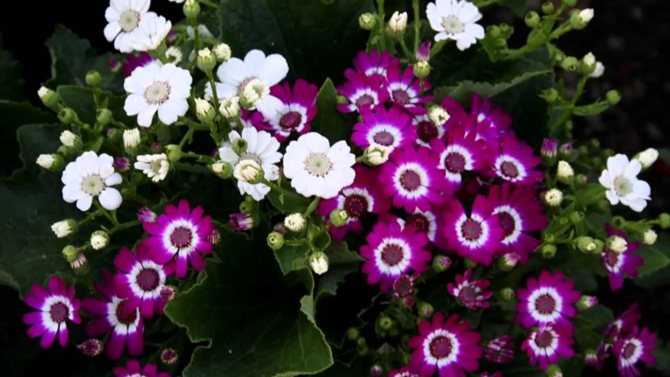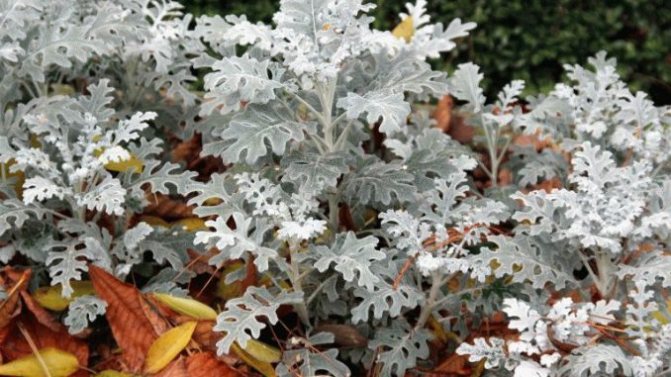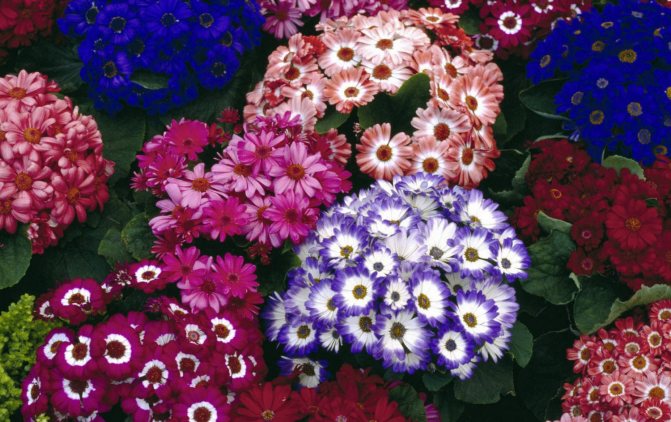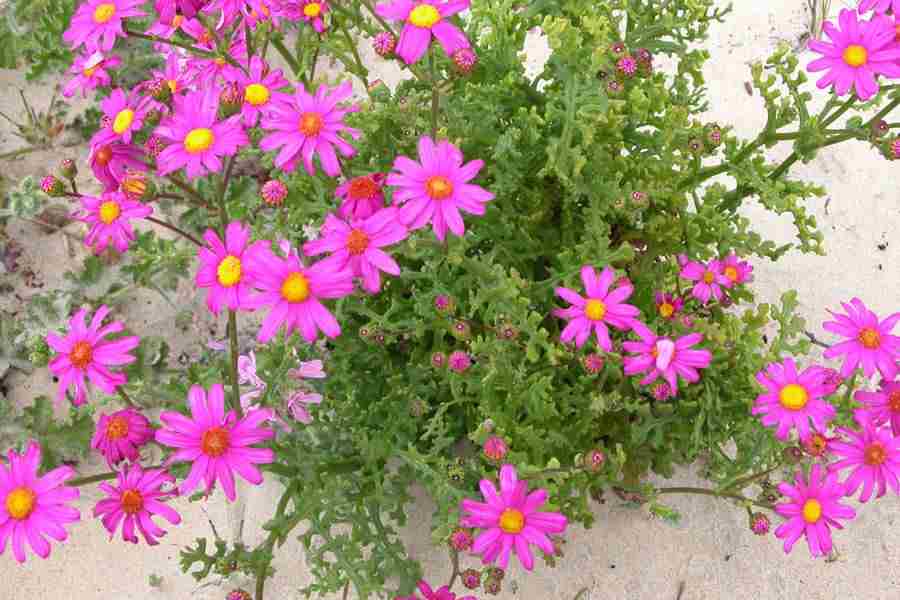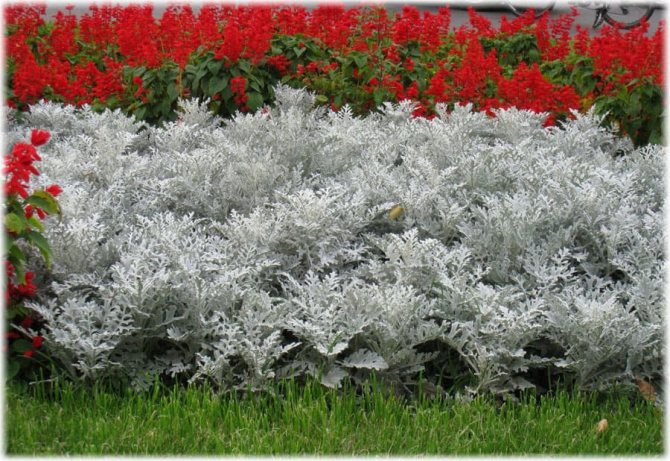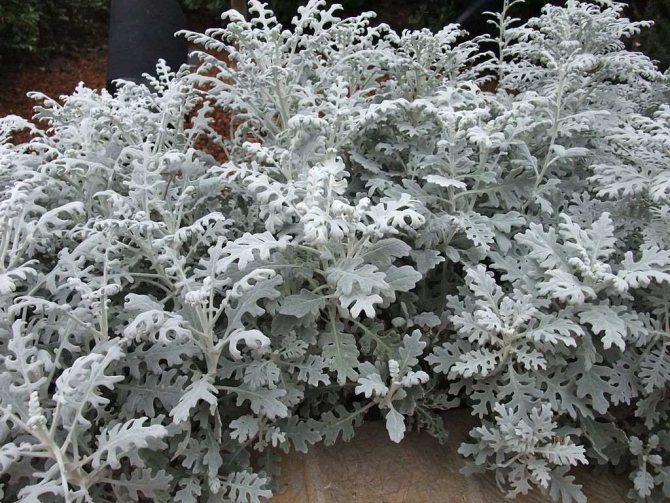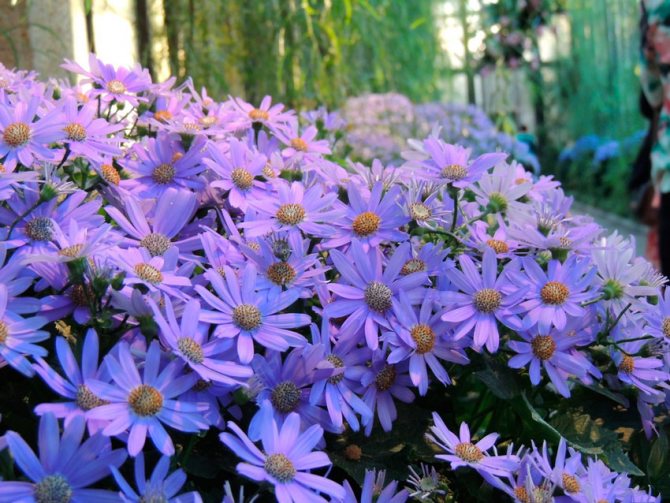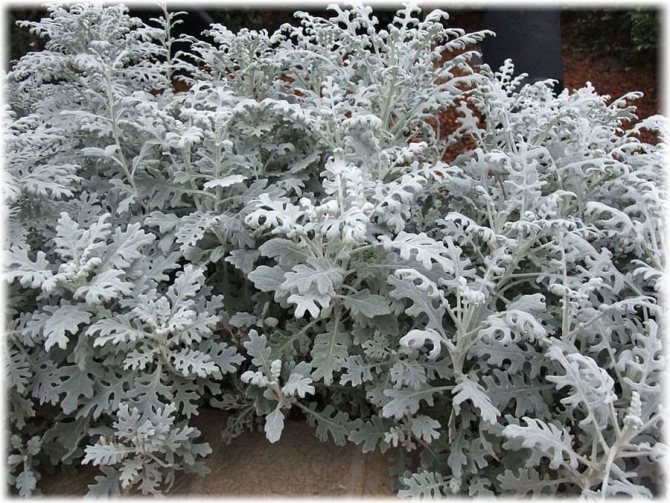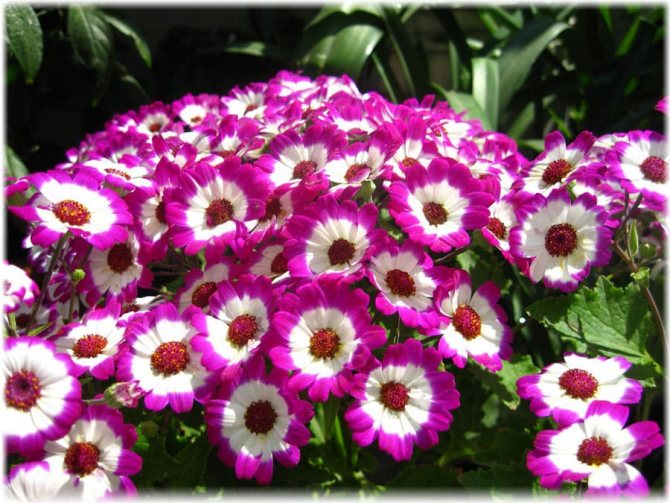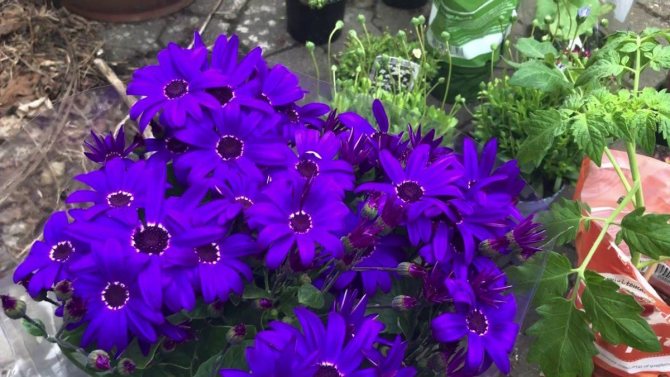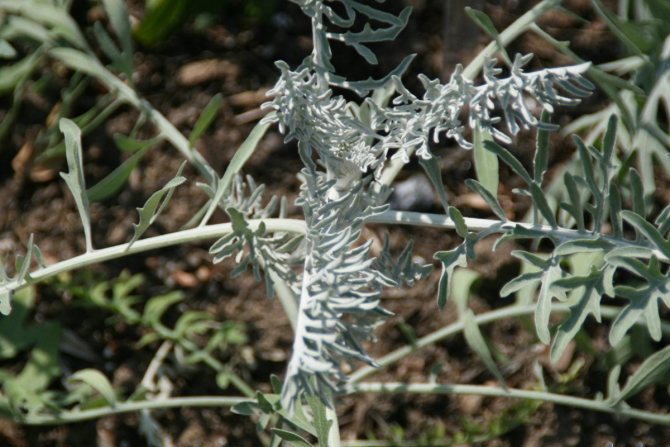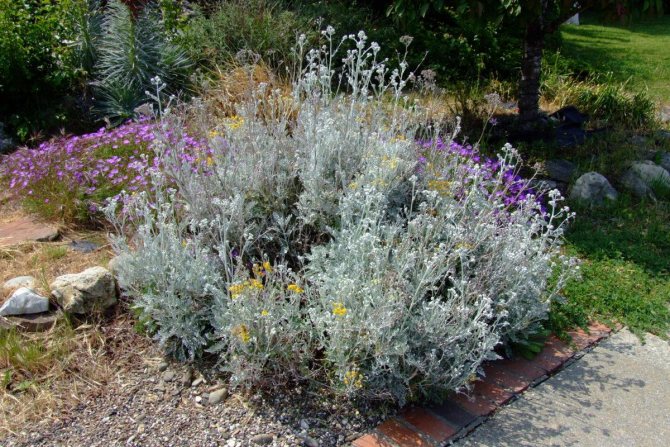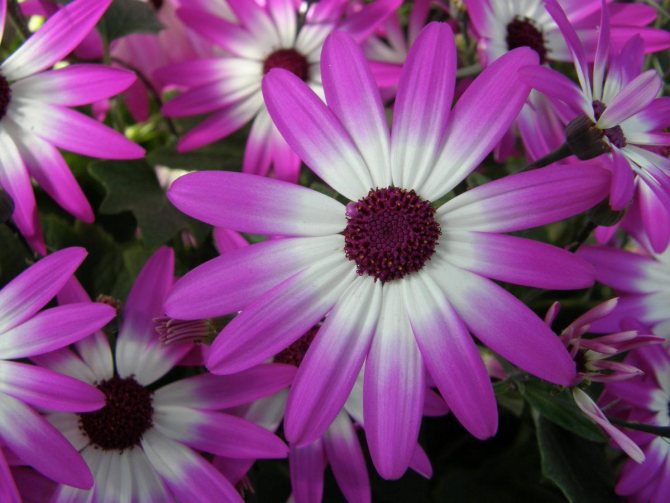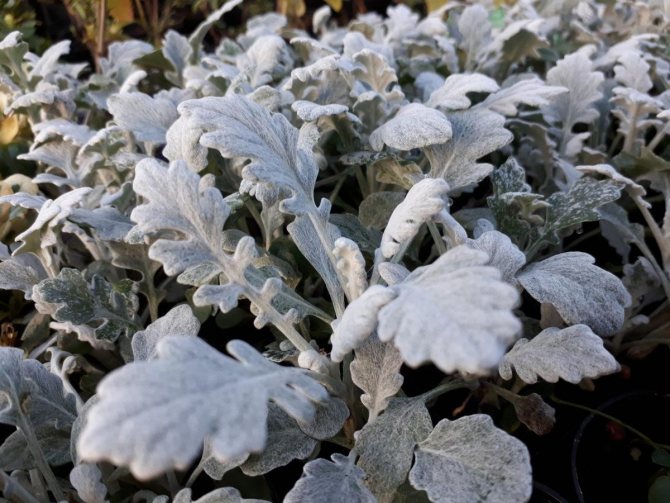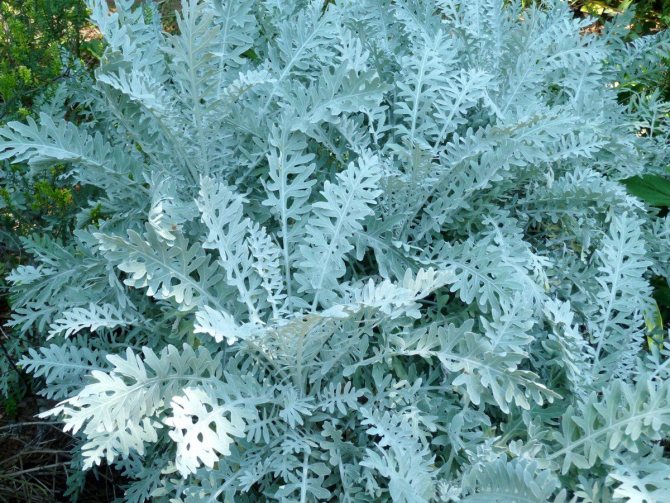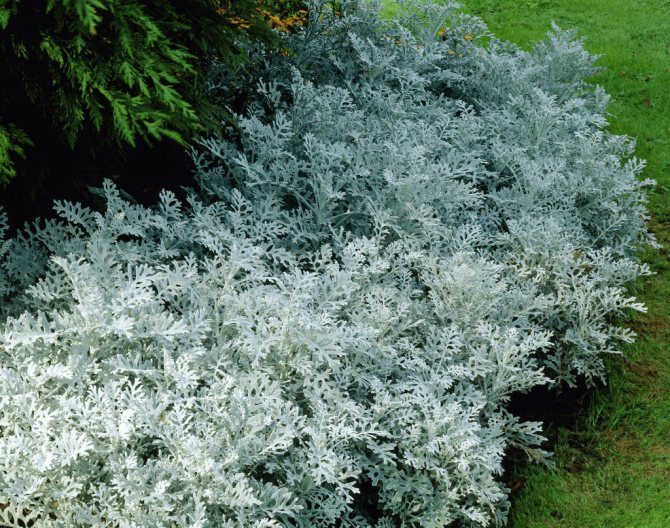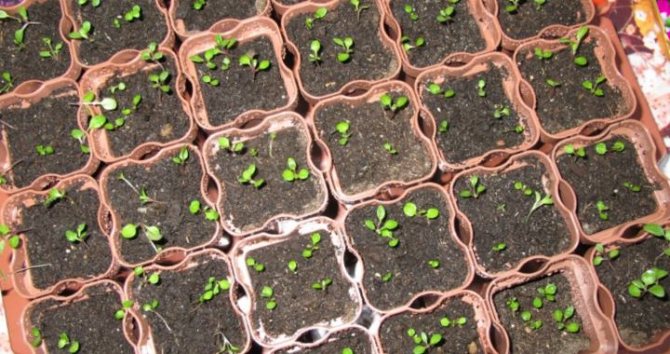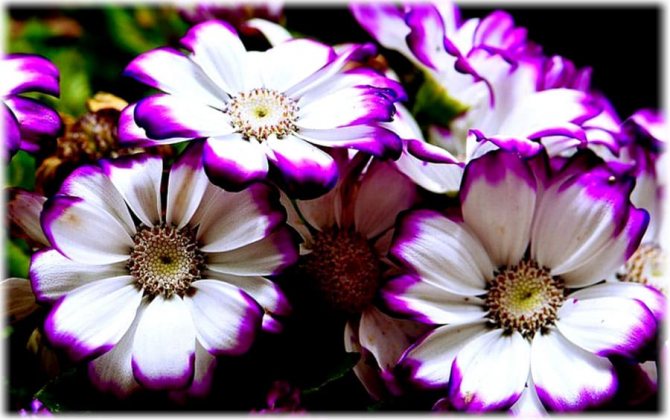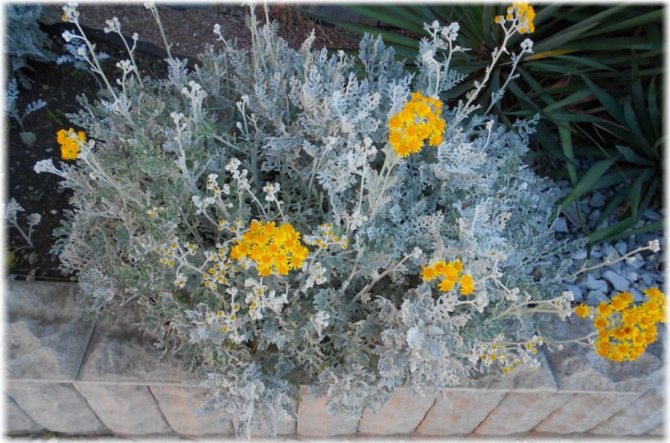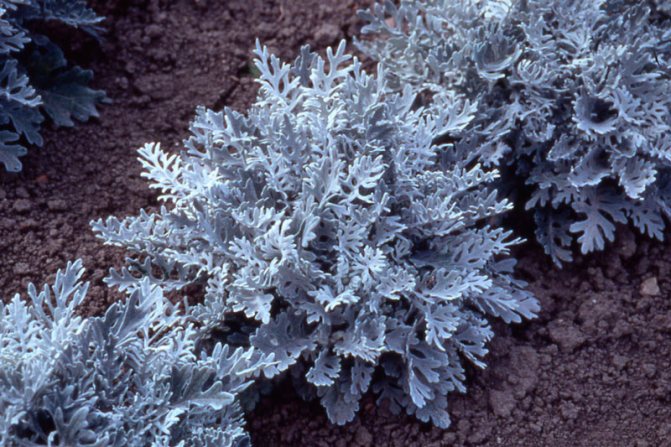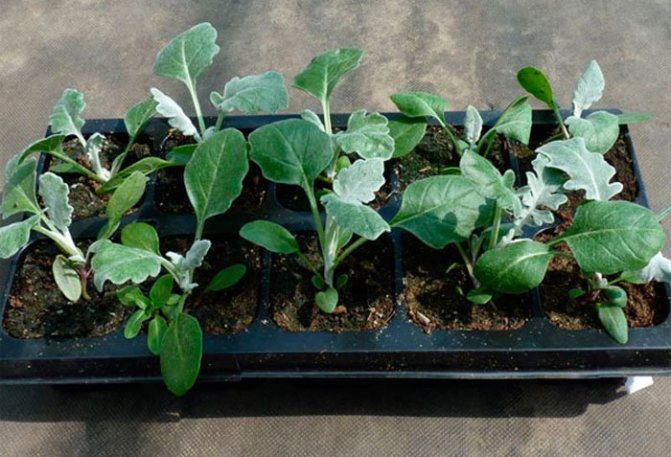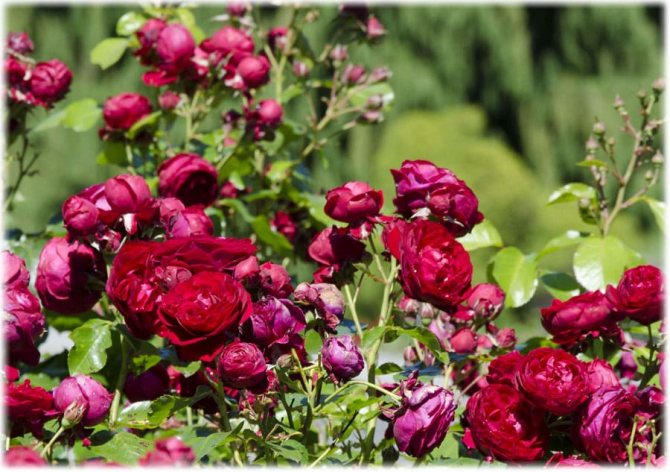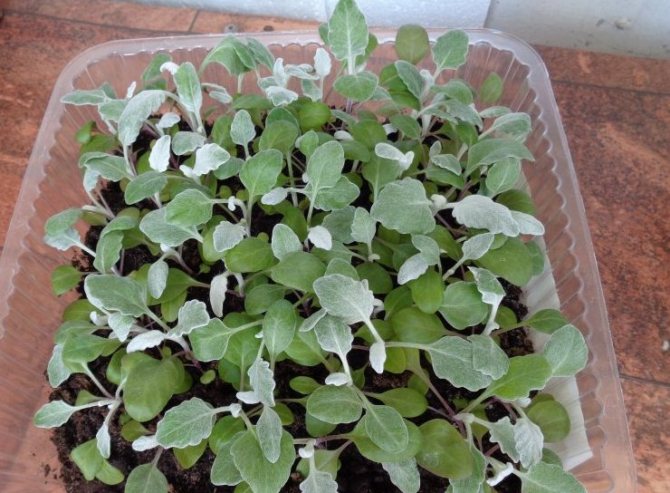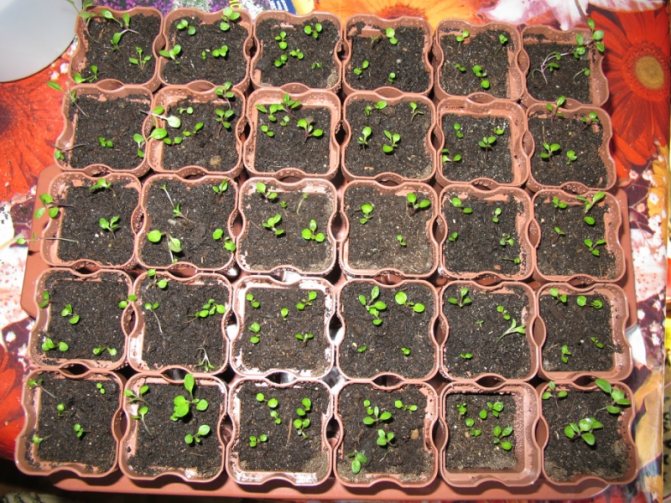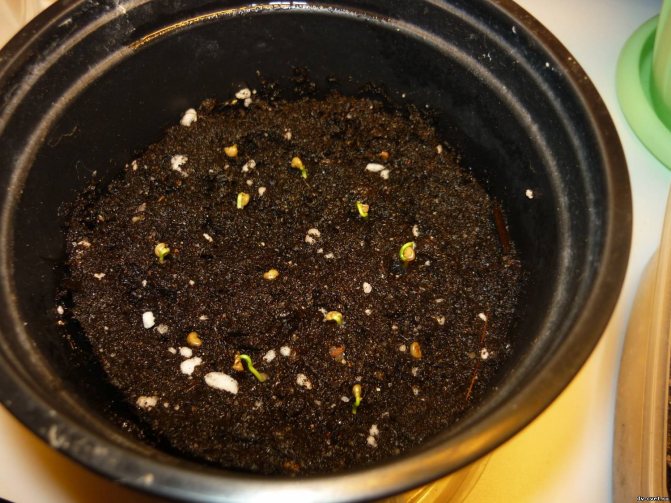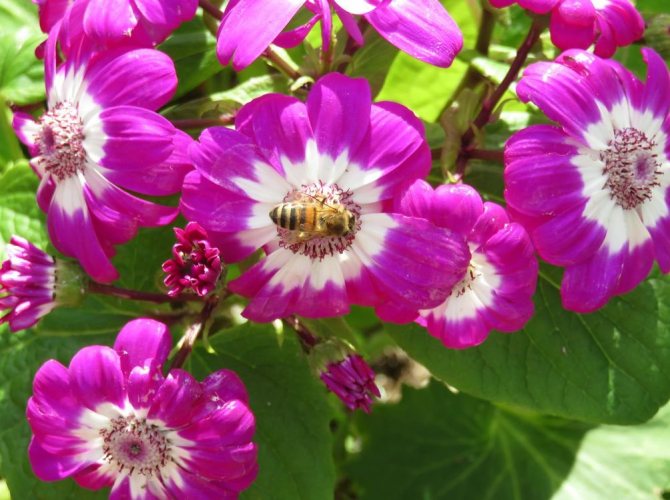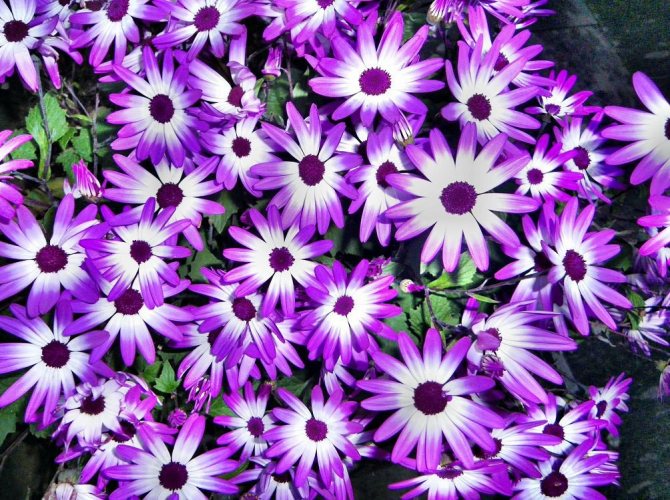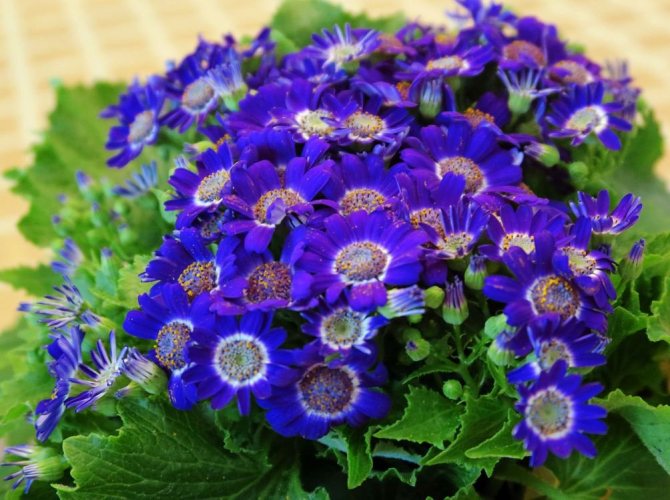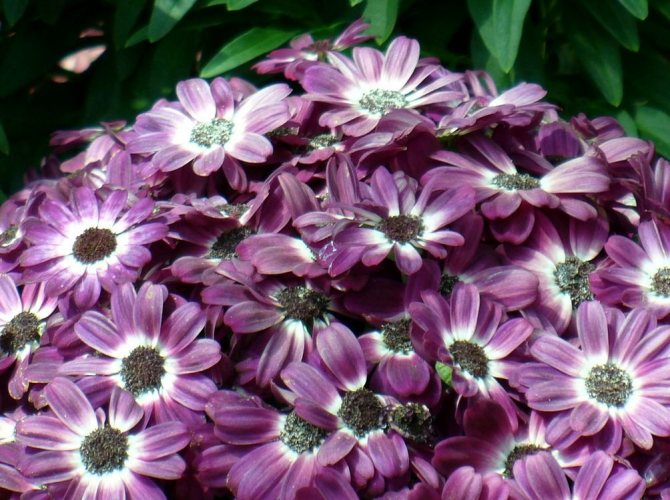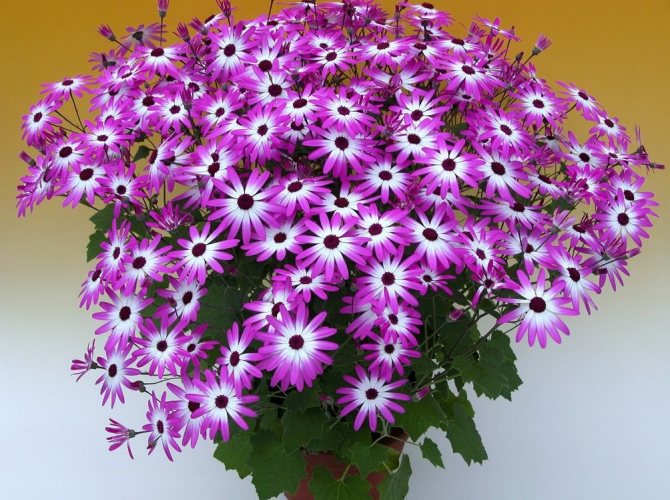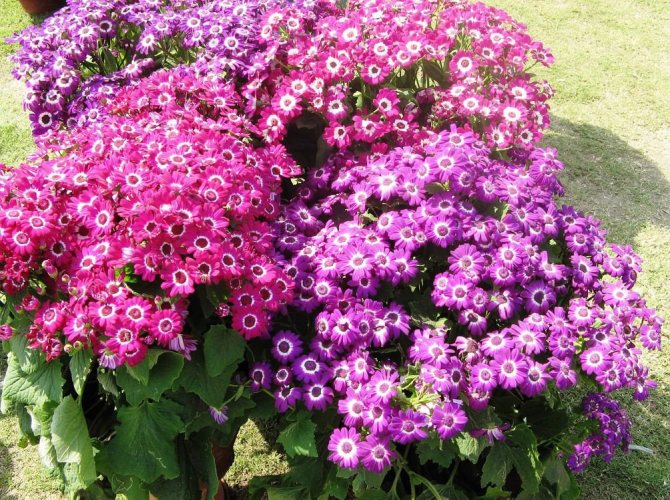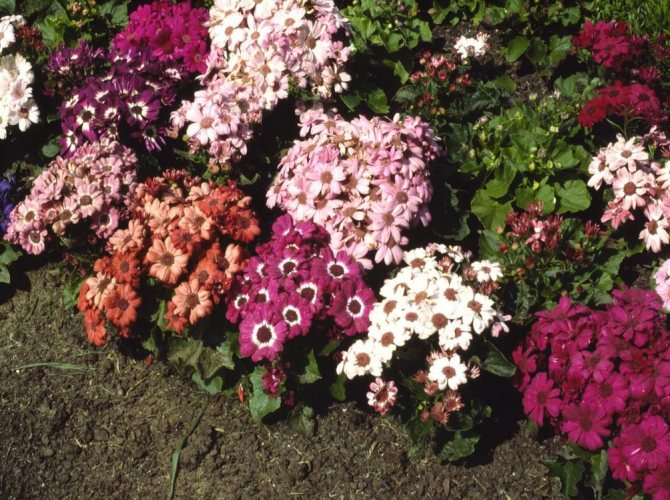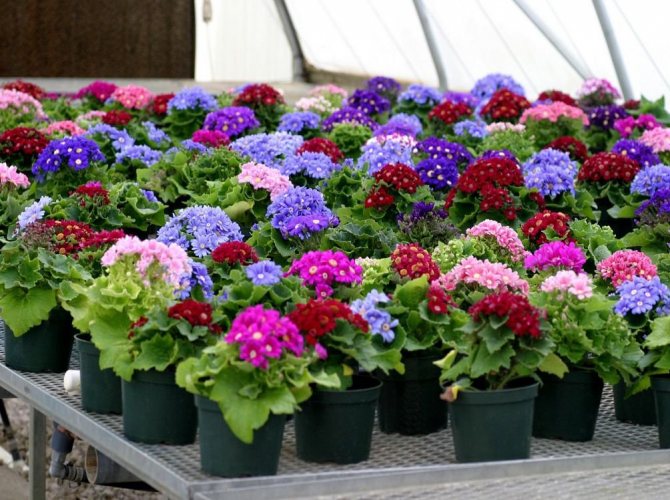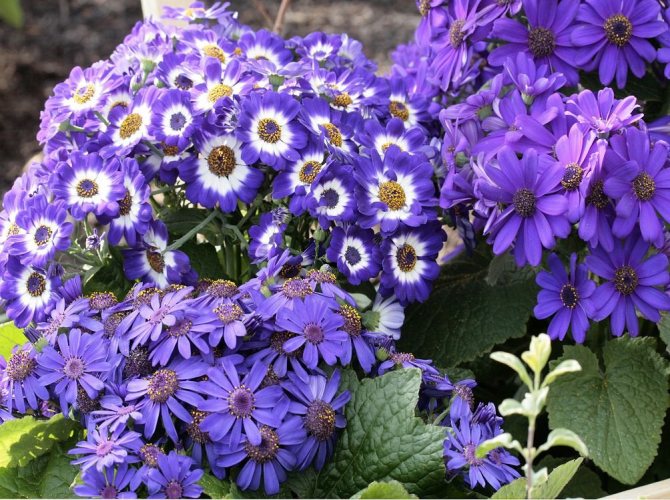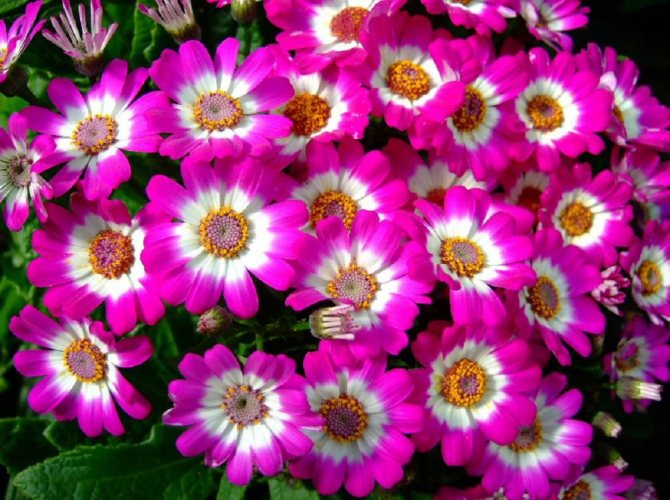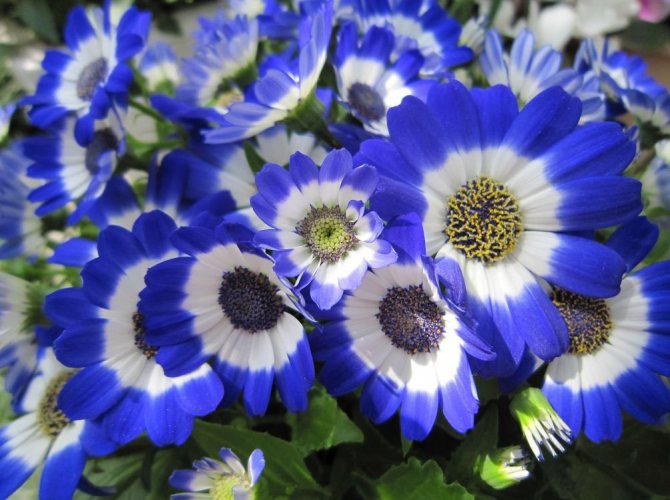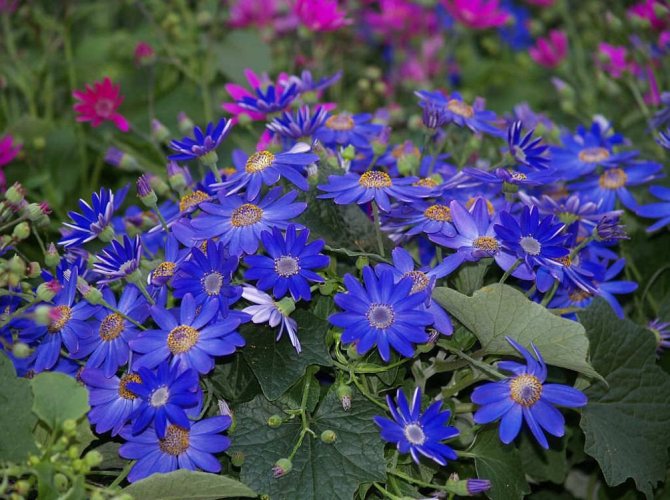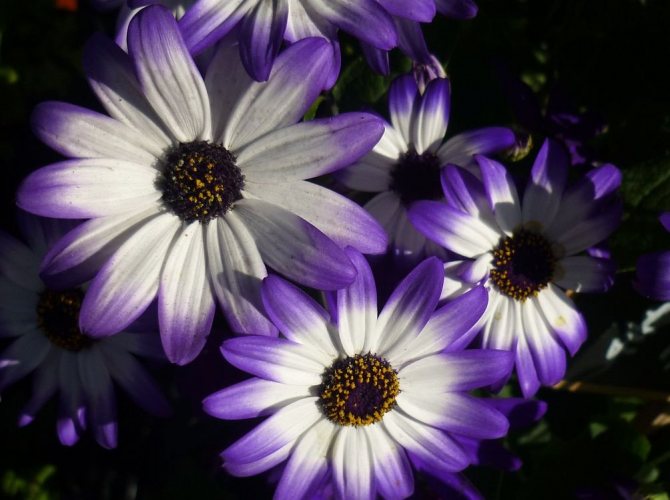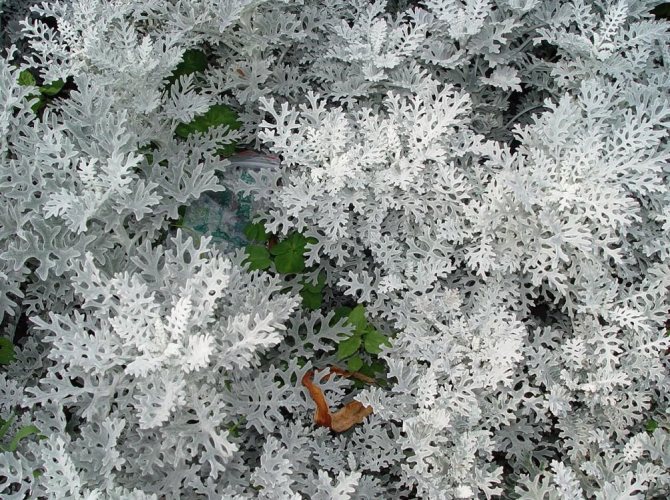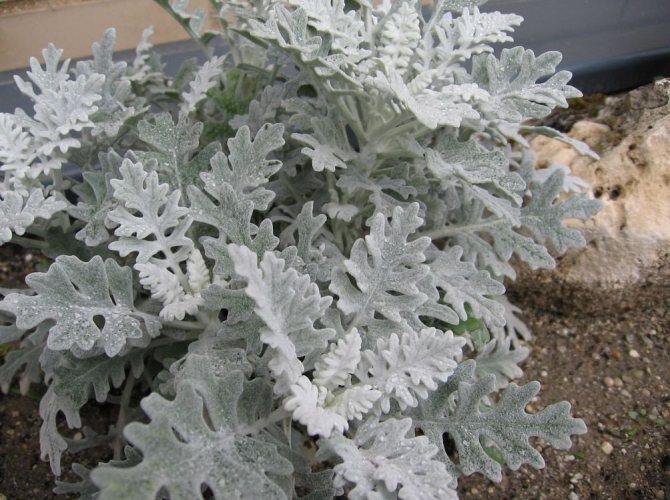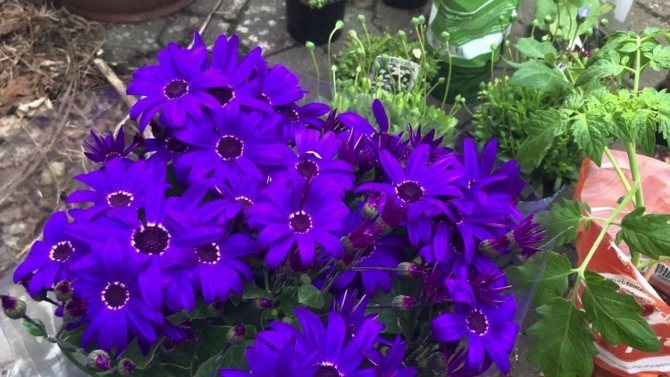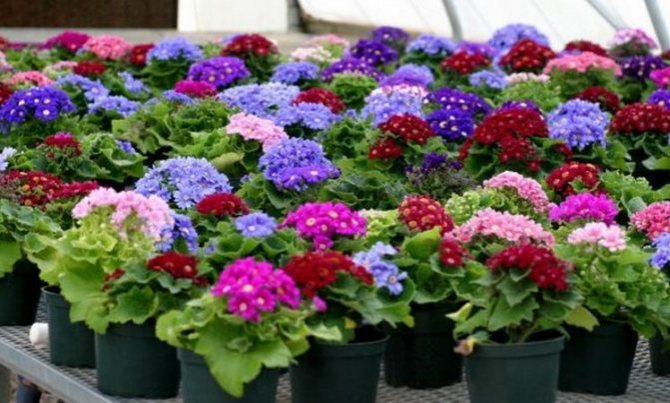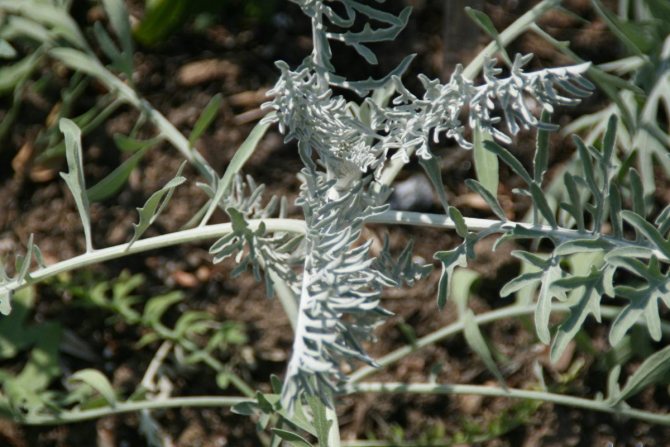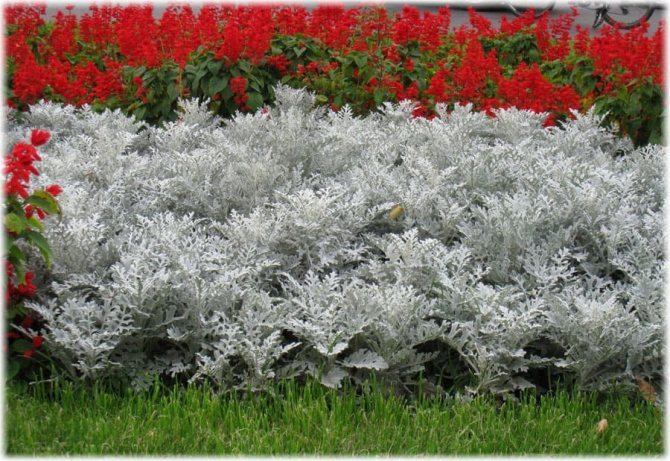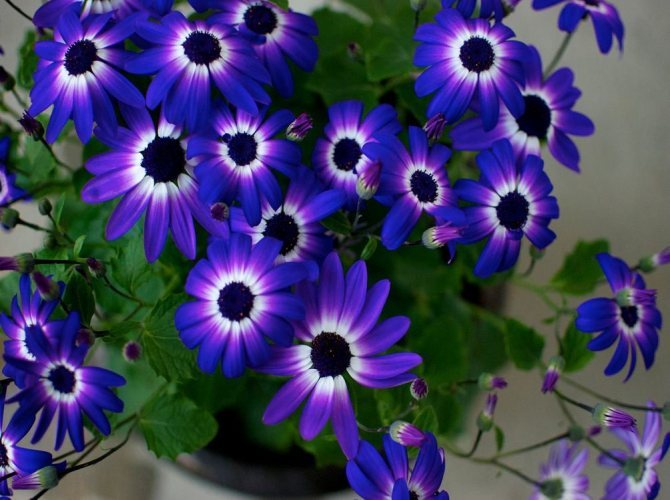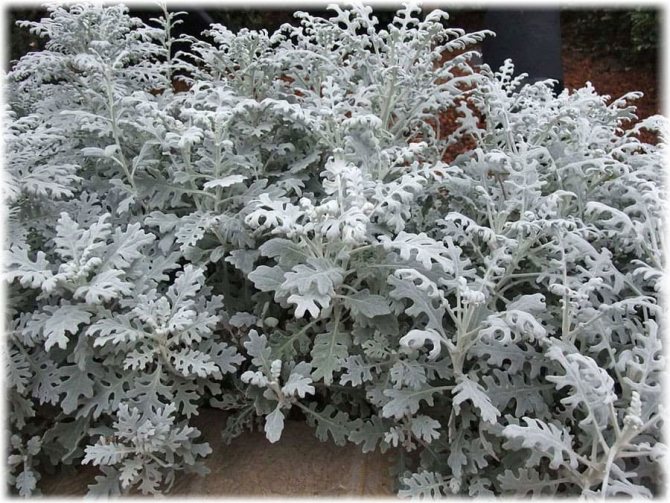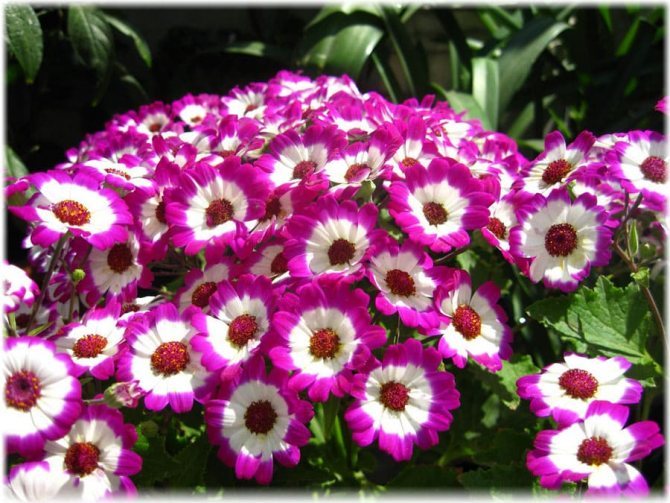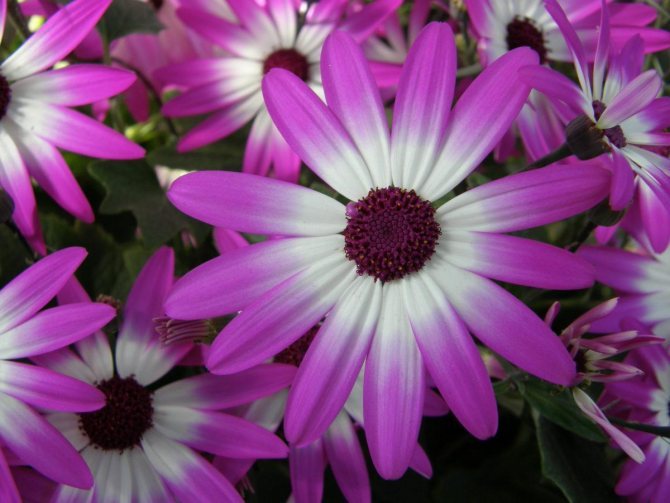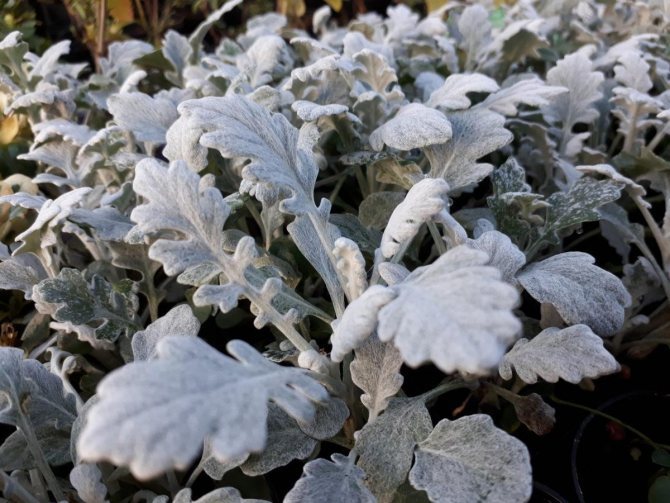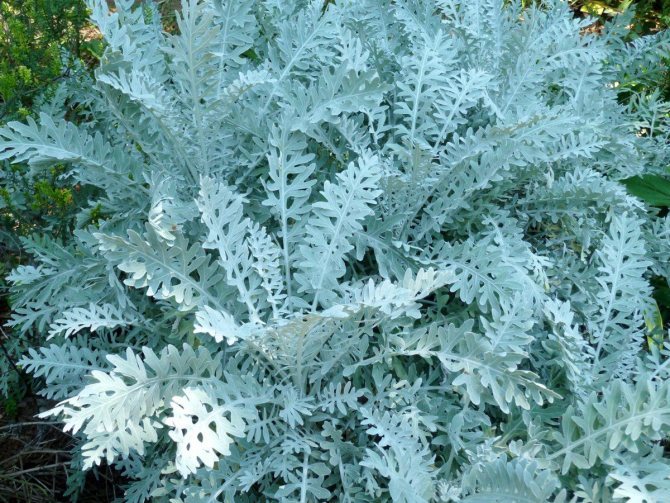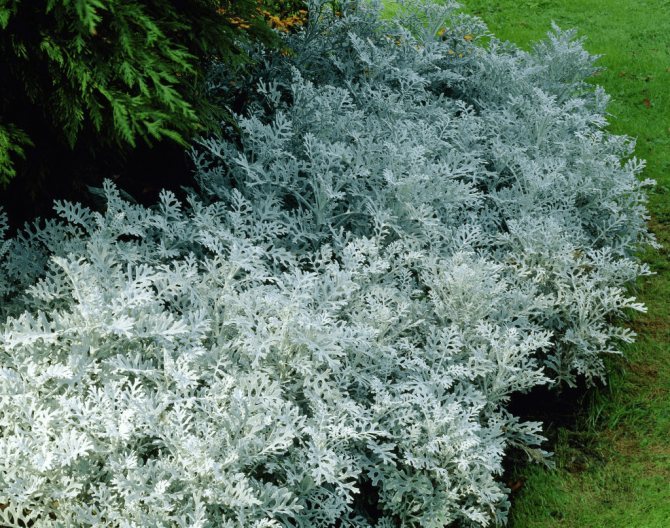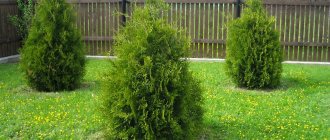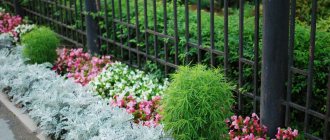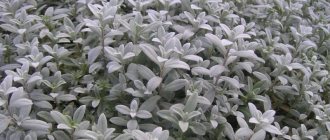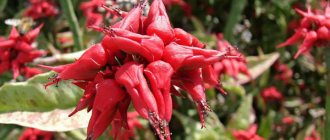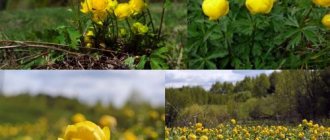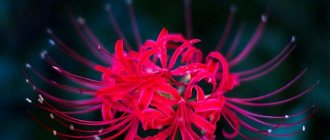Cineraria - a perennial plant adapted for indoor cultivation. Often, the flower is grown in gardens and greenhouses, where the life span is 1-2 seasons. The Aster family has more than 50 species. Homeland - tropical Africa, Madagascar, or the Canary Islands. Cineraria is a shrub or herbaceous plant.
Types and varieties of cineraria with photos and names
Cineraria bloody, or hybrid (Cinerariacruenta or Seneciocruentus, or cinerariahybrida), it is red - a hybrid between two natural species from the Canary Islands, bred in 1777 in the British royal gardens.
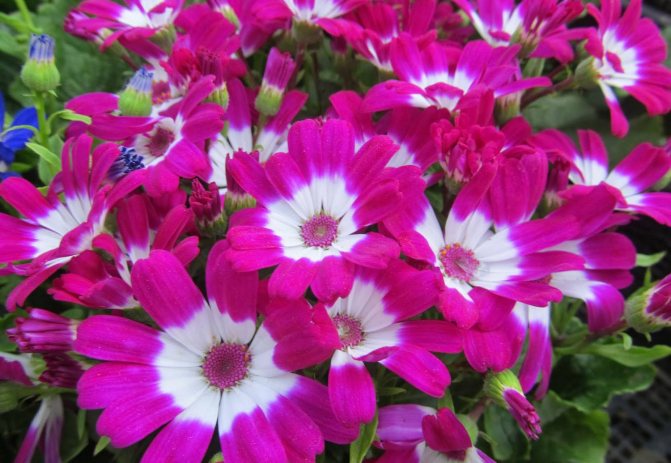
The flowers are outwardly similar to daisies, the leaves are oval, light emerald in color with solid edges. The varieties with two-color petals and terry corollas are very beautiful.
The palette of inflorescences is varied - snow-white, crimson, pale pink, cornflower blue, dark purple, blue-azure, scarlet. The plant also has a pleasant, even delightful aroma.
In garden floriculture, varieties of hybrid cineraria are popular:
- Grandiflora (Grandiflora) - bushes about half a meter in height with bright and large inflorescences of various colors;
- Stellata (Stellata) - tall plants with stems about 70 cm and small star-shaped flowers, collected in loose umbellate inflorescences;
- Nana (Nana) - low, but very dense compact bushes with dense bright inflorescences.
Seaside cineraria or silvery (cinerariamaritima) - in botany it is better known under the name Seneciocineraria - seaside russet, or ashy.
A spectacular plant native to the Mediterranean, densely pubescent with white hairs, as if covered with frost or sprinkled with ash.
The leaves are lobed and dense, deeply incised or dissected, and it is they that give the entire plant a graceful openwork beauty.
The flowers of cineraria silvery are inconspicuous, small, yellowish, they are collected in few umbellate inflorescences.
Florists usually remove them so as not to spoil the decorative plantings, however, in the middle lane the plant rarely blooms.
Cineraria marine is a perennial, but it is grown more often as an annual flower. A beautiful lyrical synonym for the plant is known - "silver dust".


Cineraria variety Silverdast, or cineraria Silverado (Silverdust, Silverzverg) - short plants about 25 cm with finely dissected leaves.
The ash-tree ground plant Candicanc also has graceful thinly dissected leaves, but the bush is much taller - about 45 cm.
The dwarf varieties of cineraria maritima Cirrus and NewLook have only slightly cut leaves.
Cineraria graceful (senecioelegans), or graceful groundwort, is a natural species native to South Africa with a basal rosette consisting of pinnate dissected leaves covered with sticky hairs.
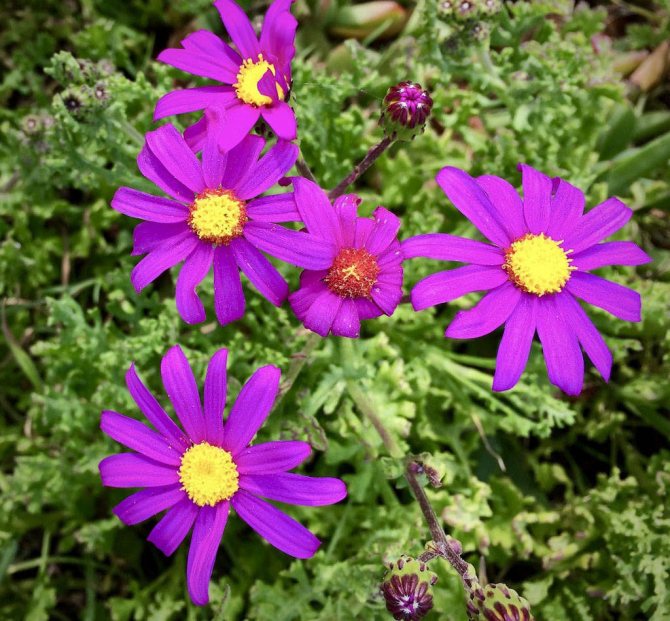

Corollas are simple or double, the colors are different, in the center there are numerous tubular flowers of a bright yellow hue.
It blooms from July to autumn, looks less luxuriant than its relatives, but is more unpretentious.
Famous varieties:
- Nanus - dwarf bushes no more than 25 cm tall with dense inflorescences;
- Ligulosus is a double-headed hybrid with various corolla colors.
Botanical description of cineraria silvery
This plant has many names: silver cineraria, seaside Jacobian, ashy groundwort. But most gardeners call it just cineraria. Jacobaea maritima belongs to the numerous Asteraceae family and has many species. At home, in the Mediterranean, it is an evergreen shrub or semi-shrub, reaching a height of 60 cm, in our flower beds the plant is much more modest - most often not higher than 25 cm. But one thing remains unchanged - the stunning beauty of completely pubescent leaves of an amazing silvery color. Simple, strongly dissected, they are very decorative.
Cineraria blooms with not too decorative flowers-baskets, which have a mustard-yellow color. They look like daisies not only in appearance, but also in structure: rather long marginal ligulate and low tubular flowers tightly fitted to each other, making up the middle. The diameter of the flowers is about 1.5 cm. But the plants are not valued for them, therefore, the peduncles are cut off in the garden so that the plant does not lose its decorative effect. But if you allow the cineraria to bloom, it will give seeds - cylindrical achenes.
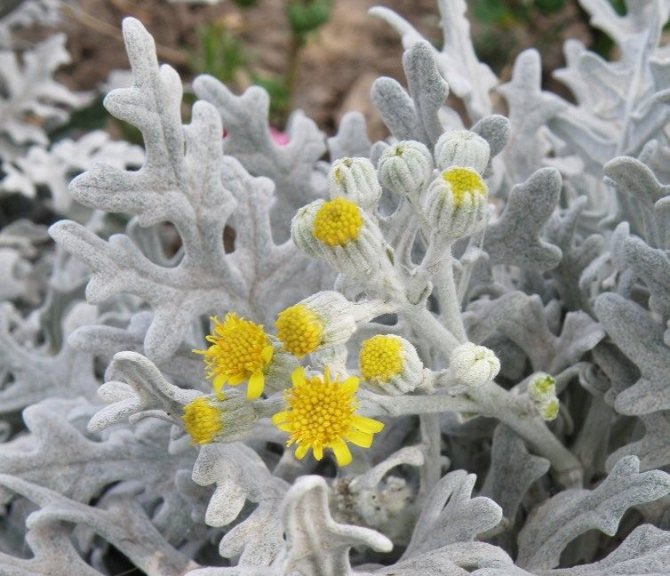

Cineraria blooms with not too decorative flowers-baskets that have a mustard-yellow color
Do not try to taste this garden beauty - the stems and leaves contain an alkaloid, which is the strongest muscle relaxant that acts like curare poison.
The plant is quite unpretentious. In the Mediterranean, it is able to withstand not only heat and drought, but even strong winds from the sea, carrying a lot of sea salt. But excess moisture is harmful to him, so you should not get carried away with watering. When planting, you need to provide good drainage so that the water does not stagnate. The most comfortable place for the growth of cineraria is partial shade, where it will fully reveal its potential and achieve maximum decorativeness.
We also recommend reading:
16 of the most popular indoor plants Physalis: description of species and varieties, technology of growing from spruce seeds in landscape design: the best decorative varieties and features of growing Kalanchoe: description of species and features of care at home
Growing cineraria from seeds
The agrotechnology of various types of cineraria is different, since representatives of one species have a long growing season, others have a shorter one. Breeding methods are also distinctive.
All species reproduce by seed, but flower growers have noticed that sowing in open ground practically does not germinate, therefore cineraria is usually grown from seedlings.
Sowing dates for different species do not occur in the same months of the year.
When to plant cineraria seedlings
The longest growing season for the bloody groundwort is up to 8-9 months.
If you sow seeds in December, and plant them in open ground in spring, by autumn the plant will decorate the garden with colorful colors of tight umbrella inflorescences.
The seeds are planted on seedlings in a loose nutritious soil, they are not sealed deeply, they are scattered over the surface, slightly pressing with a palm.
Cover with glass from above.
Containers with crops are placed in a moderately warm place with a temperature of 18-20 degrees, the mini-greenhouse is regularly ventilated and condensate is removed.
After 2 weeks, shoots are shown. When they have two true leaves, they are dived into separate pots or large common containers, but planted at a distance of 10-15 cm from each other.
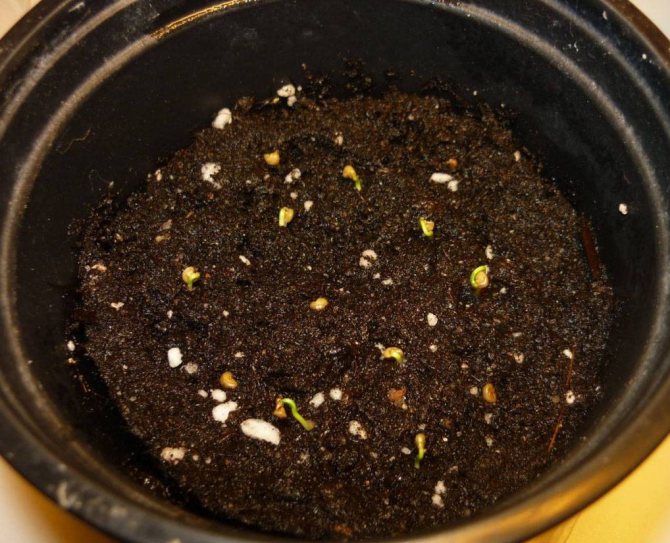

After picking, the plant is placed in a room with a temperature of no higher than 15 degrees Celsius so that flower buds form.
Bloody cineraria is transplanted into open ground in late spring, when the threat of recurrent frosts has passed.
Cineraria graceful and seaside are planted for seedlings in late March or early April in boxes under glass or directly in a greenhouse. Seedlings appear in 10 days.
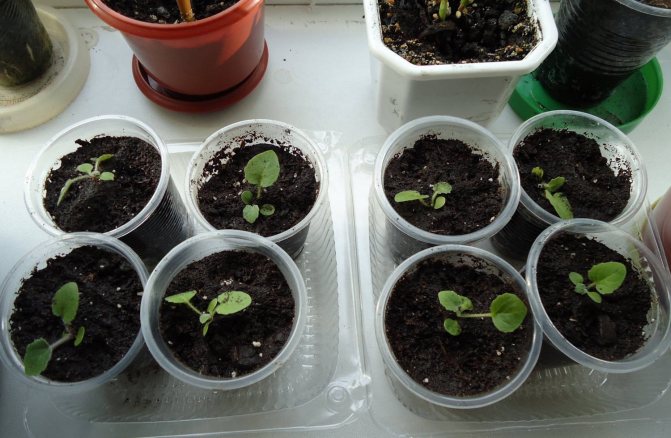

They also dive after the formation of 2 leaves and also then lower the temperature of the content.
In open ground, seedlings are moved in mid-May.
Graceful cineraria, according to flower growers, can be sown directly to the garden when the snow melts and the earth warms up, but most lovers of beautiful bushes agree that it is not worth hoping for good germination with this method of sowing.
Care difficulties, advice
It is extremely difficult to withstand all favorable regimes, therefore, only one species is grown at home, bloody cineraria, all the rest die.
- Lack of flowering, as a rule, is accompanied by the maintenance of the flower at high temperatures, excessive or low watering, possible drafts or disturbed lighting.
- A bitch lump, or sub-zero temperatures, lead to yellowing and leaf fall.
In cineraria, inflorescences and faded baskets are cut off when they appear.
When grown in greenhouses and gardens without heating, the bushes are thrown off with leaves, thereby protecting themselves from frost. In early spring, the frozen and dried leaves are cut off. The flower will not withstand extremely low temperatures.
Ventilate the surface of the cineraria often to prevent infections.
Vegetative propagation of cineraria
By cuttings, only the decorative deciduous primorsky groundwort propagates.
Fragments of pagons about 10 cm long are cut in the summer, the cuts are powdered with root roots and buried in a prepared soil mixture of garden soil and sand, which is poured into a container with a layer of 10 cm, on top of another 5-7 cm of clean sand.
Before planting, the substrate is spilled with a weak pink solution of potassium permanganate.
Cover the cuttings with a plastic bottle cut to half, watered every other day.
The appearance of new leaves is evidence of successful rooting, after which the shelter is removed for an hour or two a day, accustoming the seedlings to the environment.
Cuttings overwinter in a cool room, and in the spring, with the arrival of heat, they are planted in a flower bed.
Varieties
- ‘Cirrus’ (Cirrus) - 45 cm, oval, whole leaves with a wavy edge, silvery-white;
- ‘New Look’ (New Look), - 30 cm, large round-heart-shaped leaves of a silvery-green color;
- ‘Silver Dust’ (Silver dust) - 25-30 cm, silver-blue color of leaves, high frost resistance;
- ‘Diamond powder’ - 20 cm, silvery-ash color of the leaves;
- ‘Silver gnome’ - 20 cm, white-silver leaf color, frost-resistant;
- ‘Andromeda’ - up to 15 cm high, pinnately divided leaves of a silvery color.
These varieties were bred with a denser pubescence, a lower height and more filigree leaf shape, in a flower bed or in pots they look better than the species.
Planting cineraria in open ground
The plant prefers a sunny place with light shading at midday and fertile non-acidic soil in a well-drained area.
Cineraria is very cold-resistant and drought-resistant, but they plant it in the garden after the last spring frosts on the soil.
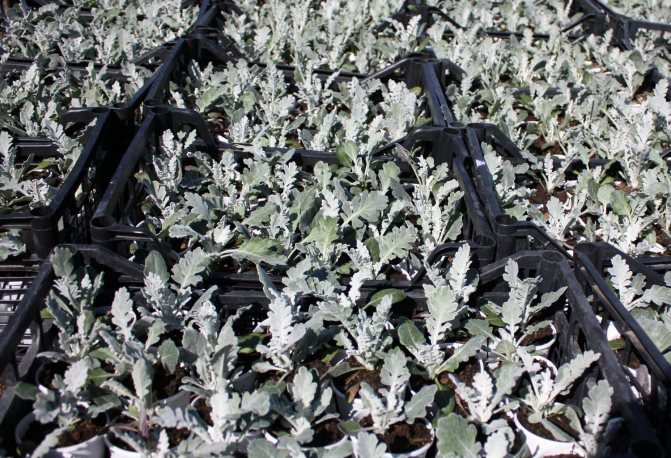

In the garden, holes are dug at a distance of about 20-25 cm from each other, no less deep than the height of an earthen coma in pots with seedlings, because it is better to transfer the plants into the ground with the substrate in which young cineraria grew.
Sprinkle the seedlings with earth, slightly compact the soil around the root collar, then water it and crush it on top with dry soil.
Immediately after planting, they do not moisten for 2-3 days, then they begin to take care of the planting according to the rules of agricultural technology.
Description of the plant
Cineraria are perennial grasses or shrubs with erect, highly branched shoots. The height of the vegetation is 30-90 cm. The plant is fed by a thick taproot, which goes deep into the soil.
Along the entire length of the stems, large petiolate leaves of a lyre, oval or pinnately dissected form grow. The surface of shoots and leaves is densely covered with a short soft bristle of bluish-silvery shade. The leaves are quite large and form a continuous soft sod.
In mid-June, inflorescences-baskets bloom on the tops of the shoots. They are simple or terry. Several rows of reed flowers of red, white, yellow or purple color grow along the outer edge. A lush core with tubular flowers is not limited to one color, it can be yellow, silver, cyan, or purple.
Replacing each other, cineraria inflorescences bloom until mid-autumn, until frost sets in. After pollination, dry seed pods ripen, inside which there are small oblong seeds of a dark brown, almost black color.
Outdoor cineraria care
It is not difficult to take care of the plant, the main thing is to organize rational moistening of the bushes, because from excess moisture they suffer from decay of the root system.
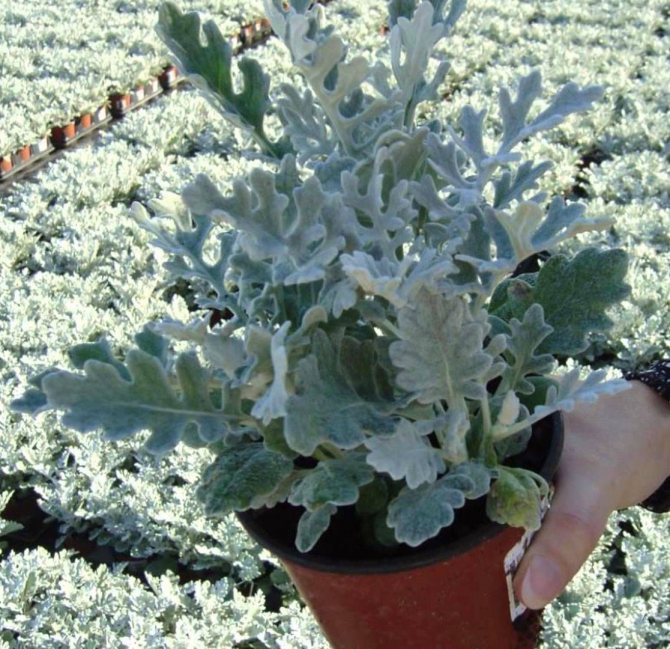

In the usual moderately warm summer, the plantings of the groundwort have enough sedimentary moisture, but during stable dry weather, the plants are watered in the evening with a rational amount of water.
After the rains, the aisles are loosened, breaking the crust on the soil surface to provide air access to the root system.
Top dressing is carried out twice or three times a month with complex mineral fertilizers.
During the budding period, beautifully flowering varieties alternate mineral complexes with organic dressings.
In decorative leafy hybrids, with the appearance of buds, unblown inflorescences are cut off - there is no beauty in them, and the plant does not need to spend energy on them.
Jacobi seaside: reproduction of a perennial
Reproduction of the ash-tree plant is carried out in several ways: sowing seeds, dividing the bush and grafting. All of them are tested and give a positive result. But experienced gardeners use only a few of them.
- Sowing seeds is the most convenient and common method.
- Division of bushes. It is used extremely rarely.
- Cuttings are usually done in mid-June, when lateral shoots appear on the plant.
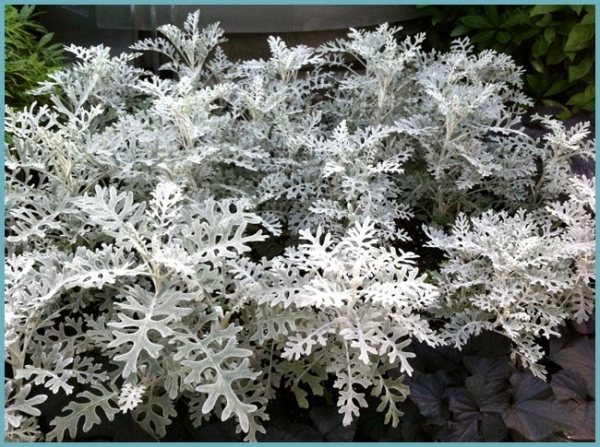

Cineraria propagates very easily by cuttings
- they are carefully cut with a sharp knife;
- placed in moist soil and create a "greenhouse effect" by covering the plant with polyethylene;
- after 2.5 weeks, roots will appear, which means that the rooting process was successful.
- cuttings are ready for planting in a flower bed.
Preparing cineraria for winter
In the middle lane, cineraria is grown as an annual plant and is simply destroyed in late autumn, but in areas with not too harsh winters, you can try to leave the varieties of the seaside species to winter in the open field.
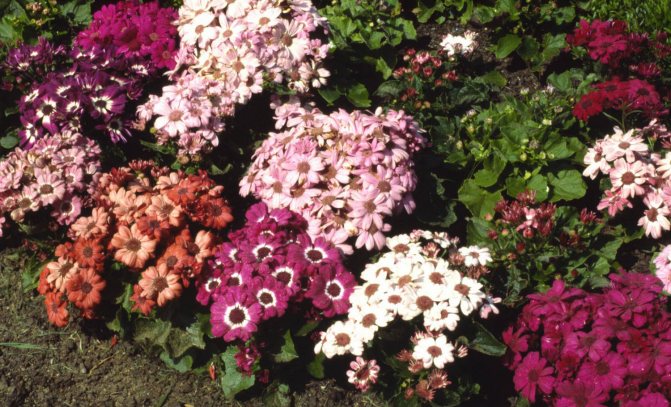

To do this, in the fall, the bushes are covered with dry foliage or spruce branches, and in the spring, frozen shoots are pruned to free up space for young growing shoots.
Some growers do differently - they dig up bushes in the fall and transplant them into containers, which are transferred to a cool and bright room for the winter.
In the spring, they are transplanted into open ground again.
Secrets
This flowering plant, judging by the reviews, is a great gift. Often on March 8, men give their halves pots with cineraria of various inflorescences: blue, white, blue, crimson, etc. If the plant is purchased at a flower shop, the buyer needs to carefully examine the bush to assess its condition. If even the slightest signs of diseases are detected, manifested by the presence of pests, as well as wilted baskets or discolored foliage, you must refuse. Such a plant is not worth buying. In addition, you should pay attention to the ratio of buds and blossoming flowers.You need to choose that cineraria, on which there are many of the former, and few of the latter.
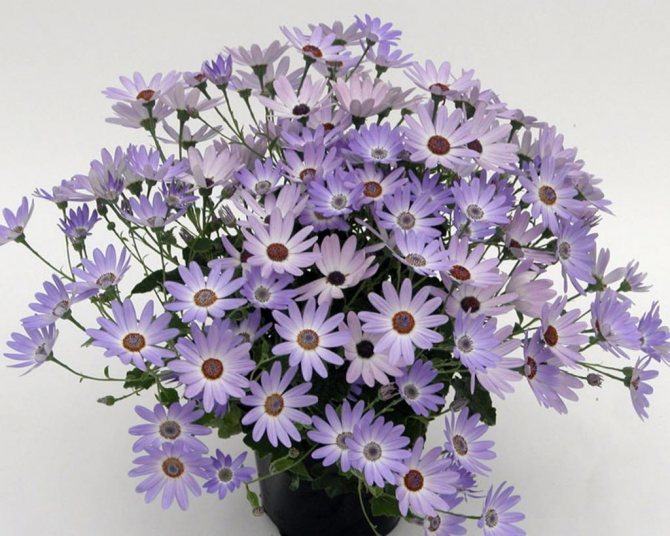

Diseases and pests of cineraria
Flowering varieties of cineraria rarely get sick, and pests do not particularly favor them, and decorative leafy hybrids are affected by rust and powdery mildew in conditions of high air humidity and high ambient temperatures.
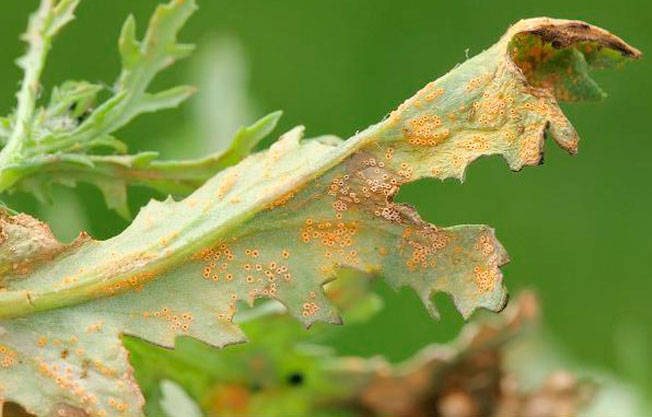

It is difficult to treat them because of the dense pubescence, so it is recommended to take preventive measures to prevent diseases.
With the appearance of the first signs of the disease, the affected bushes are sprayed with a solution of foundationol, bravo, caratan, prepared in accordance with the doses indicated by the manufacturer on the package.
The parasitic fauna of the cineraria is represented by aphids and spider mites.
From aphids they treat the ground part of the bushes with Aktara and shed the soil.
Plants infected with mites are sprayed with acaricides such as actellic or apollo.
Views
Indoor cineraria is valued by a plant lover for the fact that it blooms in the winter-spring period, when most of the potted flora is resting. This flower is often referred to as the purple daisy.
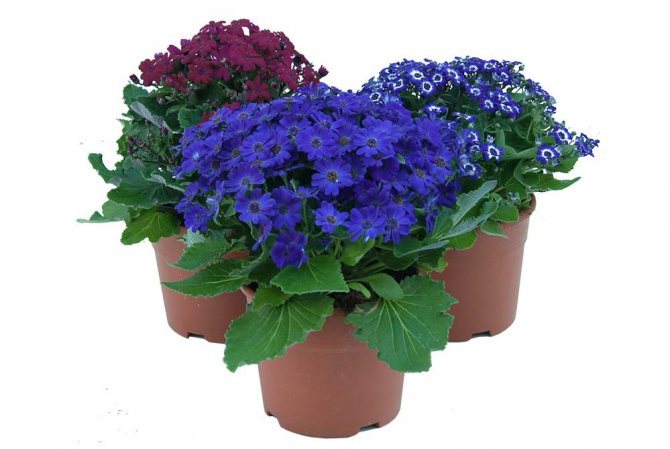

There are several decorative varieties of room cineraria:
- Double, growing up to 35-50 cm and dissolving flowers up to 5 centimeters in diameter with bicolor petals.
- Grandiflora, dissolving large inflorescences-baskets.
- Stellata with indigo-colored buds.
Cineraria in landscape design
Primorskiy rootwort is used in rabatkas and borders, to create carpet compositions in flower beds and flower beds.
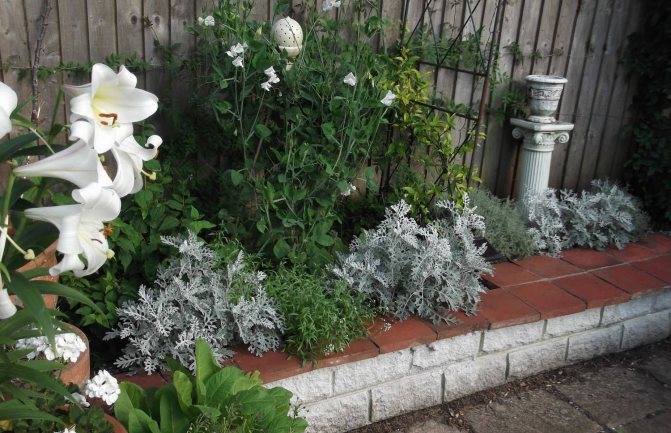

It looks spectacular in garden vases and containers. The plant is also used as a "contour" culture, combining with dark-colored leaves of canna, marigold, ageratum, alissum, petunia, geranium and perilla.
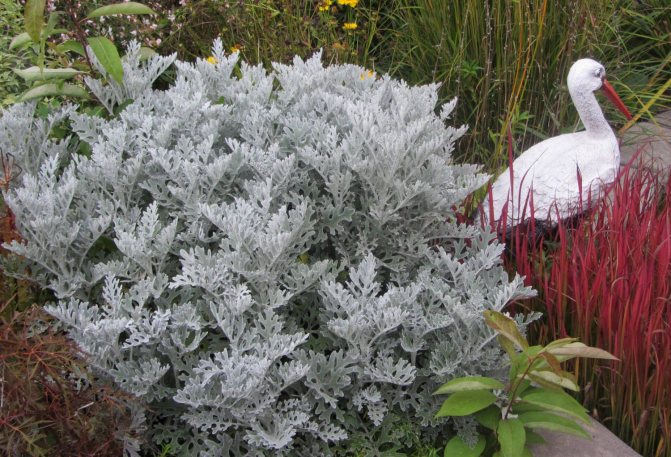

Cut and dried branches are an excellent component of dry bouquets.
Beautifully flowering varieties of bloody cineraria solo in the design of flower beds in open light spaces, participate in the creation of multi-colored carpets, decorate rock gardens, borders and mixborders.
CherryLink plugin not found
Indoor cineraria: three hybrids of this species
This flower is popular in the Canary Islands and it belongs to the family of herbaceous plants. Indoor cineraria (ciceria) has leaves resembling hearts and a ligulate bloom in the shape of a basket. As a rule, the plant usually likes to grow in pots, but after winter it can be used to decorate the garden.
This species loves warmth and abundant watering. However, do not overdo it with moisture, as root rot may occur. Does not like the flower of abundant direct sunlight and frost.
It is very easy and simple to take care of cineraria, then it will decorate not only your windowsill with its beautiful flowering, but also a flowerbed near the house or a border. There are many hybrids of this species, which differ in the size and shape of the bush, the variety of colors.
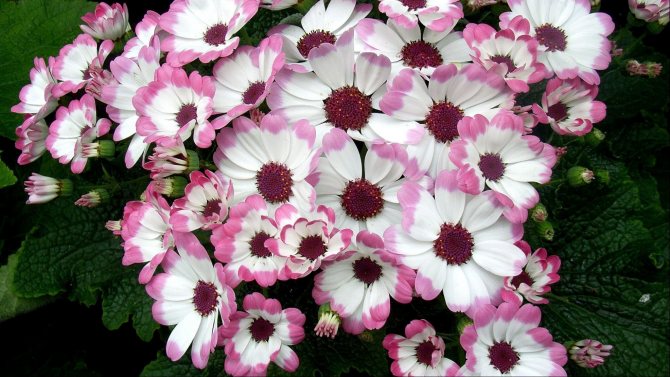

Existing hybrids:
- Small flowers in the form of stars grow up to 70 cm.
- Small bushes with bright inflorescences.
- Large flowers up to 50 cm high.
Cineraria can be planted with other flowers in mixed flower beds. It will look harmoniously with sage, phlox, petunias, as well as marigolds and lobelias. Blooming cineraria are often used to create unusual and chic bouquets. Such compositions look attractive in vases and remain fresh for a long time, do not fade.
Planting, leaving
Planting and caring for a silvery cineraria bush will not cause difficulties. The main cultivation method is sowing seeds. Less commonly, the grafting method is used, with which difficulties will not arise either.
Important! Cineraria seeds can be bought at any store, they have a high germination rate, which means that the silvery beauty will definitely be able to settle in her flower bed.
You need to sow seeds from March to May, you can grow through seedlings or sowing directly into the ground. There are several ways to get the desired seedlings:
- Sowing seeds into moist soil. The seeds themselves are covered with earth, and covered with foil on top. So the temperature inside will be slightly higher than indoors, and seedlings will quickly appear.
- Sowing in moist soil with sand filling. Above is also a film or glass.
- Sowing in moistened soil, covering it with a sheet of paper that needs to be well moistened. Seeds will germinate through it without problems.
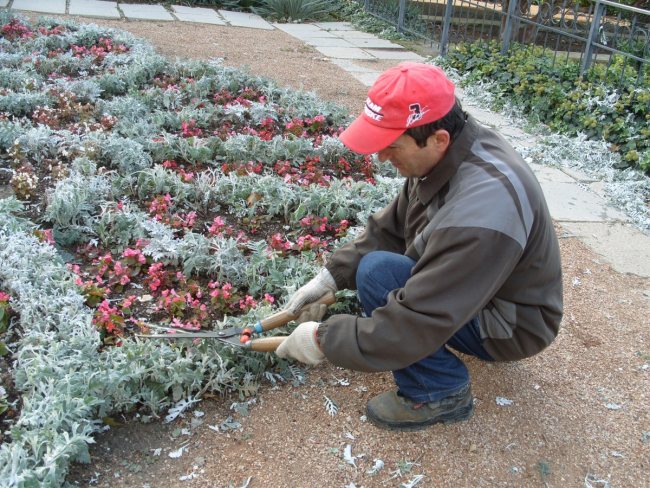

For a neat appearance, the plant must be trimmed regularly.
In order for the shoots to be fast, the container is covered with foil or glass. From time to time, the soil needs to be moistened, preferably from a spray bottle. It is not recommended to water with a stream of water, as the seeds can be washed out, and then the seedlings can not wait.
Wintering
There are two options for wintering cineraria:
- Wintering on the street. In order for the plant to easily survive any frosts, it must be covered with a sufficiently large layer of foliage. After the snow falls, it will be under a warm "fur coat" and frost will not be afraid of it.
- Digging up to frost. This is also a good option - you need to dig up the cineraria by the roots and transfer it to a cool place, optimally to the basement. It is advisable to dig it out with an earthen lump, which must be irrigated with water throughout the winter.
During the wintering period, cineraria sleeps, and with the onset of spring, its development cycle begins anew. If frozen leaves are found after winter, they must be removed.
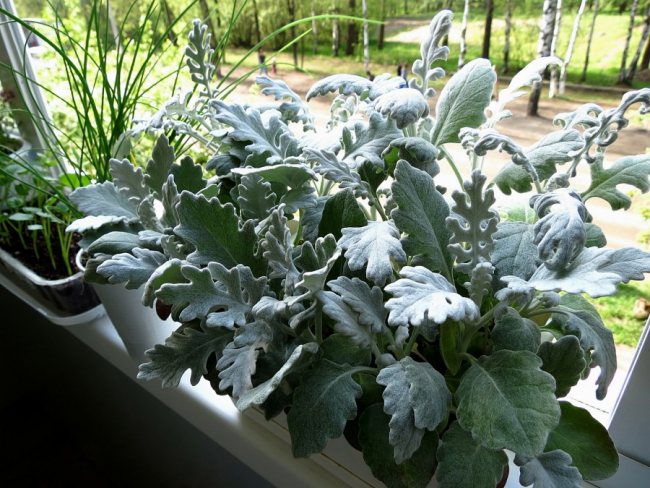

If there is little cineraria, you can dig it out for the winter.
Planting and growing
Cineraria silvery will give almost no trouble if you want to try growing from seed. They can be purchased in almost any store, the seeds are distinguished by the ability to germinate well and quickly. The best time to sow cineraria seedlings is March, but it is not too late to do this in April and also in May.
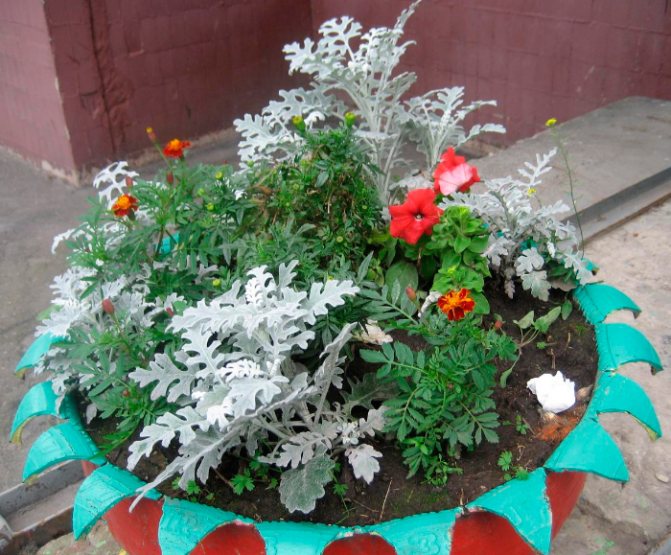

There are several ways to plant cineraria seeds - they all provide a decent result:
- You can sow cineraria in moist soil, while the seeds should not be planted, it is enough to crush them a little and cover with a film.
- Another way is to also plant the seeds in a container with moist soil, then sprinkle them with sand and cover them with glass or film.
- Finally, the seeds of cineraria sown on the outer soil layer can simply be covered with a layer of tissue paper, which, being moist, will allow the seedlings to break through it. Again, cover the container with insulating material.
In all three cases, covering with a film or glass is necessary, such an interlayer ensures that the proper level of humidity is maintained. By the way, watering the soil after planting must be done very carefully, a powerful jet can knock down small seeds and break the accuracy of planting. You can spray the ground with a spray bottle, or you can choose a container with drainage holes from the very beginning and immerse it in a stand with water so that the soil gets wet from below.


